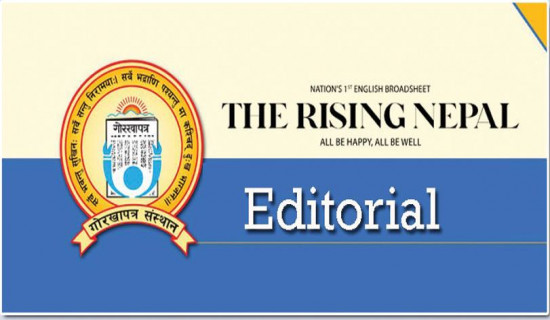- Saturday, 25 October 2025
Vulture Population Revival
Sighting of 147 nests of rare vultures including white-rumped vultures and slender-billed vultures in Sudurpaschim Province has added hope among conservationists. The sighting of nests in such a large number shows that the vulture population of these endangered large birds is steadily recovering in Nepal. Endeavours like the vulture conservation action plan, the opening of various vulture restaurants and the combined effort at national and local levels have helped vulture population thrive lately. In the mid-Nineties, these vultures had witnessed deaths in large numbers and scientific lab analysis had found that veterinary drug Diclofenac was found to be main culprit. Later, use of this drug was banned. The ban on the use of Diclofenac played a crucial role in a vulture population revival.
The total number of vultures across Nepal declined from 1.6 million in the 1990s to less than 20 thousand today. A total of nine species of vultures are found in Nepal, of them four are critically endangered. Long-billed, White-rumped and Slender-billed vultures are critically endangered species in Nepal. The opening of vulture restaurants in Nawalparasi played a key role in vulture conservation as vultures had easy access to safe carcasses of dead cattle. Likewise, Bird Conservation Nepal (BCN) has set up seven more such feeding centers in the Rupandehi, Dang, Kailai, Kaski and Sunsari districts.
After a scientific conference in Nepal, experts confirmed that Diclofenac used to treat livestock was a major cause behind the death of vultures in Nepal. The residue of this drug in the carcasses of treated livestock was consumed by vultures and that led to their kidney failure. South Asian countries including Nepal banned Diclofenac in 2006. The government has completely banned the production, sale, distribution and use of Diclofenac. Nepal has declared 76 districts as Diclofenac-free zones for animal treatment. Meloxicam was prescribed as a safer alternative to Diclofenac.
In Nepal, some vultures also die after getting trapped in unmanaged electric wires. Likewise, the lack of timely rescue of injured vultures leads to the death of many vultures. Likewise, the development of modern agricultural systems and the practice of burying the dead livestock has resulted in food shortages for vultures. Habitat destruction and various anthropogenic activities also pose challenges to vulture conservation endeavours. Recent research has identified drugs like Ketoprofen, Aceclofenac, Carprofen and Flunixin as toxic to vultures.
Vultures are known as nature's scavengers as they devour carcasses and help control epidemics like rabies, cholera and plague. Their role in maintaining ecological balance and the food chain is often overlooked. Vultures build their nests in tall trees and raise their fledglings over there. Among the nine species of vultures found in Nepal, only six build their nests on trees, while the Himalayan Griffon, Hadfor and Egyptian vultures build their nests on cliffs. One of the major setbacks for conservationists is their habitat loss due to deforestation, urbanisation and other disturbing activities.
Feeding centres operating at the local level provide healthy carcasses to the vultures. Old cattle are collected and kept at these centres and taken care of until they die. When they die the chemical-free carcasses are fed to the vultures. This endeavour boosts food availability for vultures. Nepal has witnessed steady progress in vulture conservation over the years. However, the efforts at the national level alone are not enough for vulture conservation as vultures are migratory birds and they fly over long distances. Both national and international cooperation is a must to give impetus to the conservation of these large fliers.

















